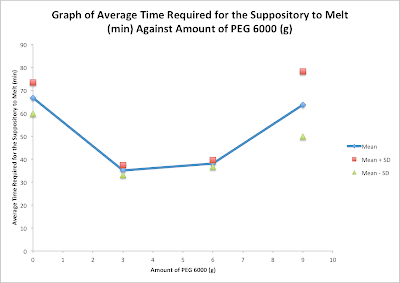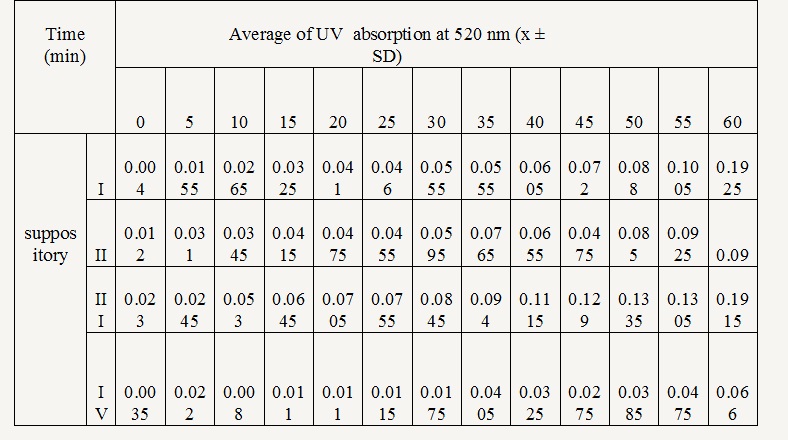Title
To evaluate the effects of
different amount of substance used towards the characteristics of a suppository
formulation.
Objectives
1) To determine the effect
of different composition of base on the physical characteristics of the
suppository formed.
2) To evaluate the release
rate of the drug from the suppository formulation.
Introduction
Suppositories
are solid dosage forms intended for insertion into the body orifices (rectum,
vagina, urethra) where they melt, soften, or dissolve and exert a local or
systemic effect. The properties of an ideal suppository base should melt at
body temperature or dissolves in body fluids, non-toxic and non-irritant,
compatible with any medicament, release the medicament readily, easily moulded
and remove from the mould, stable to heating above the melting point, easily to
handle and stable on storage.
The
following experiment determined the effect of different composition of base on
physical characteristics and the release rate of the drug from the suppository
formed.
Apparatus and Materials
Apparatus
-
Weighing balance
|
-
Water bath (37°C)
|
-
Weighing boat
|
-
Dialysis beg (10cm)
|
-
Spatula
|
-
Thread
|
-
Beaker 50 ml
|
-
Glass rod
|
-
Beaker 100 ml
|
-
Pipette and pipette pump
|
-
Hotplate
|
-
UV spectrophotometer
|
-
Measuring cylinder
|
|
-
1 set of suppository
mould
|
Materials
-
Polyethylene glycol (PEG)
1000
-
Polyethylene glycol (PEG) 6000
-
Paracetamol
Procedures
1)
A saturated paracetamol solution is prepared. (10g in
5ml of distilled water)
2)
A suppository formulation of Paracetamol is prepared
using those formula (10g)
Suppository
|
Group
|
Materials
|
Saturated Paracetamol
Stock Solution (g)
|
Total (g)
|
|
PEG 1000
|
PEG 6000
|
||||
I
|
1,5
|
9
|
0
|
1
|
10
|
II
|
2,6
|
6
|
3
|
1
|
10
|
III
|
3,7
|
3
|
6
|
1
|
10
|
IV
|
4,8
|
0
|
9
|
1
|
10
|
3)
The suppository is made into a shape using suppository
mould that is available. Discuss and compare the shape, texture and colour of
the suppository formed.
4)
One suppository is inserted into the beaker containing
distilled water (10 ml, 37°C) and the time needed to melt the suppository is
determined.
5)
One suppository is put into the dialysis beg and it is
tied both at the end nicely. Then the dialysis beg is put into the beaker
(100ml) which contain distilled water that has being heated until 37°C.
6)
Within each 5 minutes, one aliquot sample is pipette
(3-4 ml) and the liberation of Paracetamol from the suppository is determined
using UV-visible spechtrophotometer. Make sure the distilled water is stirred
using glass rod before taking the sample.
Results
Discussion
1. Compare
the physical appearance of the suppositories and give explanation.
Characteristics
|
Suppository
1
|
Suppository 2
|
Suppository 3
|
Suppository 4
|
Shape
|
Bullet-shaped
|
Bullet-shaped
|
Bullet-shaped
|
Bullet-shaped
|
Greasiness
|
Very greasy
|
Greasy
|
Slightly greasy
|
Least greasy
|
Hardness
|
Soft
|
Slightly hard
|
Hard
|
Very hard
|
Colour
|
White
|
White
|
White
|
Colourless
|
Polyethylene glycol 1000 and
polyethylene glycol 6000 are used as bases of Paracetamol Suppository.
All the suppositories were
of the same size, which is a bullet-shape. This is because the same type of
mould is used during the preparation of Paracetamol Suppository. All the
suppositories also have the same size.
Suppository 1 only contains
Polyethylene glycol 1000 (PEG 1000). Suppository 2 contains more Polyethylene
glycol 1000 (PEG 1000) than Polyethylene glycol 6000 (PEG 6000). Suppository 3
contains more PEG 6000 than PEG 1000. Suppository 4 only contains PEG 6000.
All the suppositories have
different degree of greasiness. Suppository 1 is very greasy. Suppository 2 is
greasy. Suppository 3 is slightly greasy. Suppository 4 is the least greasy.
PEG 1000 is less hydrophilic than PEG 6000. Property of PEG 1000 contributes to
high greasiness. PEG 6000 is more hydrophilic. High amount of PEG 6000 will
cause the suppository to be the least greasy.
PEG 6000 has higher melting
point than PEG 1000. Therefore, suppository 4 is very hard compared to the
other suppositories. Suppository 1 is soft because PEG 1000 has a lower melting
point. Suppository 1, 2 and 3 are white whereas Suppository 4 is colourless.
From the result, it can be deduced that PEG 1000 cause the suppositories to be
white. PEG 6000 causes the suppository to be colourless.
2. 1. Plot
graph time that required for the suppository to melt against amount of PEG 6000
in the formulation. Compare and discuss the result.
Amount
of PEG 6000/g
|
0
|
3
|
6
|
9
|
||||
Group
|
1
|
5
|
2
|
6
|
3
|
7
|
4
|
8
|
Time
required for suppository to melt/min
|
61.90
|
71.45
|
33.72
|
36.47
|
39.21
|
37.11
|
74.00
|
53.54
|
Average
of time/min
|
66.68
|
35.10
|
38.16
|
63.77
|
||||
Standard
deviation
|
6.75
|
1.94
|
1.48
|
14.47
|
||||
ẋ
+ standard deviation
|
73.43
|
37.40
|
39.64
|
78.24
|
||||
ẋ
- standard deviation
|
59.93
|
33.16
|
36.68
|
49.93
|
||||
From the graph we can see that the amount of PEG
6000 influenced the time taken for the suppository to melt. PEG 6000 has high
molecular weight of ethylene oxide and it is a water-soluble chemical. As it is
water soluble , and due to low dielectric constant, the drug tend to remain in
the base and release of acetylsalicylic acid may be slow. So, from this we can
assume that by increasing the amount of PEG 6000 , it will slow down the release
of acetylsalicylic acid. Based on the graph, the suppository that has the
highest amount of PEG 6000 took longer time to melt. However, for the suppository
that has no amount of PEG 6000 at all, took longer time to melt compared to the
suppository that has amount 3g and 6g of PEG 6000. This is because it has
highest amount of PEG1000 compared to other suppositories.
3. 2. plot the graph of uv
absorption agonists time from the procedure 6. Explain briefly about the graph.
The graph above
shows the relationship between the UV absorption against time for paracetamol
suppository. From the graph, we can observe that the UV absorption of suppository
increases with time. The value of UV absorption is relate to the amount of
paracetamol release from the suppository in the dialysis beg into the
surrounding solution in the beaker. This experiment show the release of the
drugs from the suppository formulation into the blood circulation in our
body. The dialysis bag serves as the phospholipid membrane bilayer and
the distilled water in the beaker acts as the blood plasma. Also, the
temperature of the system was maintained at 37oC, which represents
the body temperature. Diffusion mechanism is applied for the drug paracetamol
to pass the dialysis bag into the water. From the graph plotted, when the
time increases, the amount of the paracetamol diffuse into the distilled water
also increases, thus results in gradual increased in the UV absorption value as
more of the UV light is being absorbed.
Theoretically,
the amount of paracetamol in the suppository is high at the beginning of time.
But after a while, the drug is slowly being diffuse into the water through the
dialysis bag because the water is hypotonic. thus makes the concentration of
the gradient difference. But when the concentration gradient is equal, the drug
will not diffuse into the water because the water is already concentrate with the
drug.
4.
Plot the graph of UV absorption against time for suppository formulation that
have different composition. Compare and discuss the results.
From the graph and the table above, we
can see that the value of UV absorption for suppository I increase with
time and fluctuated for suppository II,
III and IV.
Suppository I and II contain more PEG
1000 than PEG 6000. So, the hardness of the suppository is less compared to
suppository III and IV because they contain more PEG 6000 than PEG 1000. When
the hardness increase, the release of paracetamol into distilled water will be
difficult. So the UV absorption will be low.
From the graph, we can see that the
value of UV absorption for suppository III is on the top compared to others.
This may be due to some errors that occur during the experiment because the
value of UV absorption that supposed to be on top is the suppository I since it
does not contain any PEG 6000.
The precaution when doing this
experiment are the suppository need to be done in accurate ways such as
accurate weighing of materials, make sure the temperature of water bath is
correct and clean the cuvette first before put it in spectrometer UV-visible.
All of this is to make sure the results that will be obtained is precise.
5) What is the function of each material used on the
suppositories preparation? How the composition of PEG 1000 and PEG 6000 can
affect the physical characteristic and the drug releasing rate from the
formulation?
In
the suppositories, polyethylene glycol (PEG) is used as the bases where the
active ingredient is blended together with.
Bases are playing the important role in releasing and holding the drug
from the carrier. Thus, it is directly controlled the bioavailability of the
drug. Polyethylene glycol is an water-soluble base which easier to be dissolve
in the water. As the experiment used two types of the polyethylene glycol which
are PEG 1000 and PEG 6000. The number of PEG indicates the molecular weight of
the polyethylene glycol. The high number means high molecular weight.
As
the molecular weight increased, the hardness also increased. So, in term of the
hardness, PEG 6000 will be makes the suppositories harder as compared to PEG
1000. If the formulation used more PEG 6000 instead of PEG 1000, it
suppositories produced hard and vice versa. Once the suppositories hardness in
altered, the releasing rate also will be altered. If the hardness of
suppositories increase, the active ingredient is more difficult to be released.
It is related with the melting point where the high molecular weight of PEG has
the high melting point. The colour also based on the composition of the PEG
type. The low molecular weight of PEG will make the clear suppositories.
As
conclusion, the molecular weight of the PEG can affect the formulation and the
releasing rate of the suppositories by varying the composition of the PEG type.
Conclusion
Different percentage of combination of PEG 1000 and
PEG 6000 affects the physical characteristics of the suppository and the rate
of release of the active ingredient.
References
·
pharmlabs.unc.edu/labs/suppository/bases.htm


















0 comments:
Post a Comment